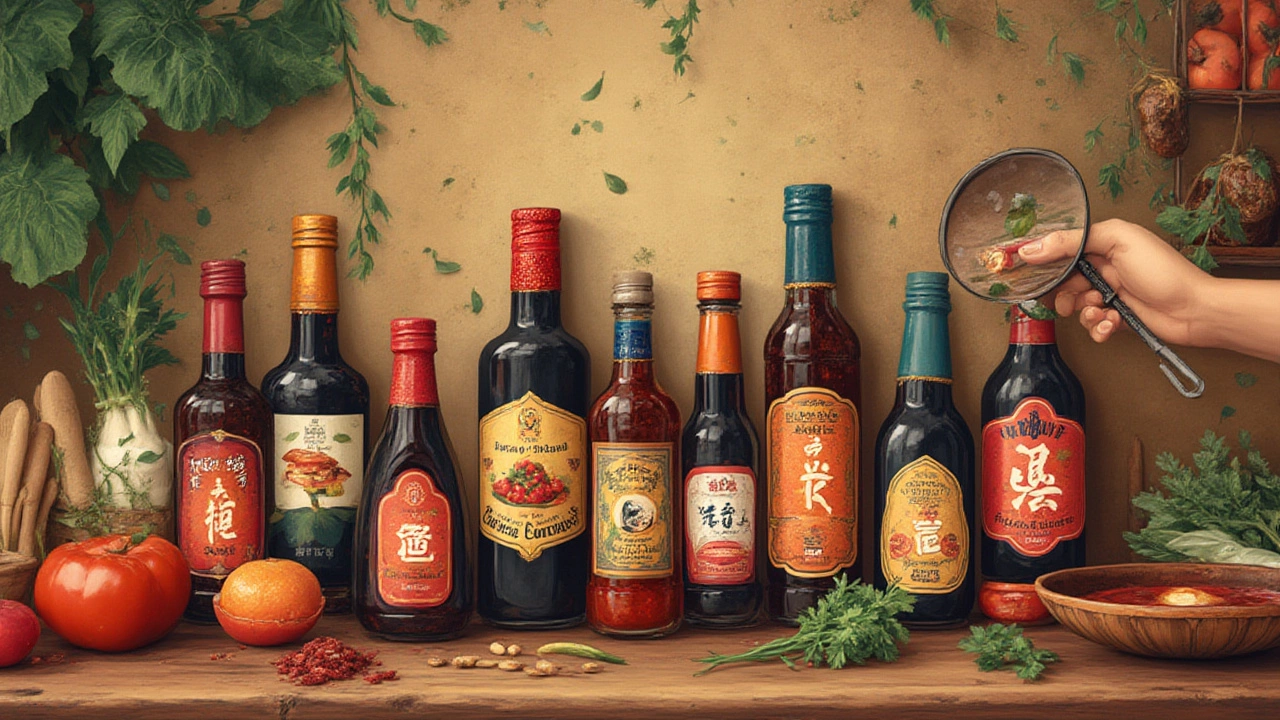Soy sauce is one of those kitchen staples you’re sure to find stashed somewhere behind the olive oil or lurking by the sushi kit. A few shakes over fried rice, splashed into a veggie stir-fry, or pooled in a dish beside dumplings—it’s salty, it’s umami-rich, and it seems so simple you wouldn’t think twice. Except, well, if you’re vegan, you might want to think twice. Not every soy sauce is what you expect. Surprised? You’re not alone. Even Muffin, my nosy tabby, once licked a drop off the kitchen bench and then sniffed her bowl suspiciously the next time soy showed up at dinner. Let’s talk about why soy sauce isn’t always as vegan as it sounds, and what every plant-based foodie should know before reaching for that dark bottle.
What is Soy Sauce and How is it Traditionally Made?
Soy sauce has a story stretching back more than 2,000 years. It started in China as a way to stretch salt by fermenting it with soybeans. It eventually spread across Asia—picking up fans in Japan, Korea, Indonesia, and beyond. At its core, soy sauce seems basic: soybeans, wheat, water, and salt. You mix, add koji mold to get fermentation bubbling along, let it all sit in barrels for months (sometimes years), strain, and bottle. The result is a dark, punchy liquid that tastes like umami in liquid form. In Japan, you’ll hear it called shoyu; in Korea, it’s ganjang; in Indonesia, kecap manis or kecap asin, depending if it’s sweet or salty. All sound innocent enough, but take one look at a supermarket shelf and suddenly you’re swamped—light soy, dark soy, gluten-free, low sodium, mushroom, tamari... the list goes on.
Most soy sauces made the traditional way should be vegan-friendly–fermented primarily from soybeans and wheat, with salt and water tossed in. Some artisan brands do exactly this, and a short ingredient list is usually a good sign. There are even variants that skip the wheat, like tamari, making them popular with gluten-intolerant folks as well as vegans. But that old-school clarity gets murky the moment manufacturers start tinkering. In the rush to make soy sauce cheaper, faster, or different, plenty of additives can sneak in.
Let’s get specific. In Japan, shoyu is regulated, and you’ll often get the pure, centuries-old formula: mainly soy, wheat, salt, water, with mold and time doing their thing. China’s naturally brewed soy sauces, like Pearl River Bridge’s "Superior Light Soy Sauce," tend to stick close to tradition. Things shift when you spot “acid hydrolyzed soy protein” or “hydrolyzed vegetable protein” on an ingredient label instead of fermented soybeans. These are chemically produced shortcuts that crank out sauce in days, not months. Purists turn up their noses, and vegans should too, because these can be mixed with all sorts of flavor enhancers—sometimes animal-derived.
Non-Vegan Ingredients: What’s Hiding in Your Soy Sauce Bottle?
If you’re asking if soy sauce is vegan, you probably imagined this: soybeans, wheat, water, salt, end of story. But sometimes, behind the label, there are hidden surprises. Traditionally brewed soy sauce should be vegan. But in commercial sauces and some restaurant brands, sneaky additives pop up. The biggest culprit? Fish. Some sauces include ingredients like fish sauce, oyster extract, or bonito (dried fish flakes). It can happen in fusion products, dipping sauces, or regional styles like Thai or Indonesian kecap.
Ever spotted E numbers or cryptic chemicals on your sauce label? Some food colorings and flavor enhancers (like E631 and E627) can come from animal sources. While rarer in Australian supermarket sauces, they do show up occasionally in imported brands or in ready-made glaze versions for grilling. In Japan, some regional shoyus are finished with dashi—a broth made with kombu (kelp) and, more often, bonito flakes. If you ever dash out for sushi and see “sweet soy sauce” or “house dipping sauce,” ask: some Japanese restaurants mix their own with added dashi.
Here’s a weird twist—some older recipes, especially in pre-modern Japan and China, included fermentation starters from animal bones, shellfish, or shrimp. Thankfully, almost no mass-market or reputable brands use these methods nowadays, but fetch a bottle in a rural market and check carefully.
Sugar is another sneaky player if you’re extra-strict vegan. Some countries use bone char (ground up animal bones) to bleach sugar white. In Australia, most white sugar isn’t processed with bone char, but if your soy sauce is sweetened and imported, there’s a slight chance it was. If that matters to you, pick organic or choose tamari, which usually skips the sugar.

Soy Sauce Types and Which Ones Vegans Can Trust
If I had a dollar for every soy sauce variant Muffin knocked off the pantry shelf, I’d probably just buy more for her to knock down. But seriously, soy sauce comes in so many forms it’s dizzying. Let’s break down the main ones you’ll find at Australian grocers and what vegans should check.
- Soy Sauce Vegan (Shoyu): Japanese-style, brewed with soy, wheat, salt, and water. Usually vegan, but check restaurant and fusion versions for dashi or bonito extract.
- Light Soy Sauce: Chinese-style, sharp and salty, mostly vegan but watch for flavor boosters in cheap brands.
- Dark Soy Sauce: Thicker, aged longer, slightly sweet. Some brands add molasses or caramel for color—they’re usually plant-based, but check for E numbers.
- Tamari: Mostly made with little or no wheat, popular with gluten-free folks. Tamari is usually vegan, and most Aussie brands are safe bets. Still, double-check—every brand’s different.
- Kecap Manis: Indonesian sweet soy, thick and syrupy. This is a trickier one—sometimes it’s sweetened with palm sugar, but some use refined sugar (possibly with bone char). A very few brands add fish sauce or shrimp paste! Always read the label.
- Mushroom Soy Sauce: This hits different. Super umami, but riskier. There’s usually no animal stuff, but some budget brands use flavor enhancers from animal sources.
- Seasoned Soy Sauce/Sushi Sauce: Watch these at restaurants and sushi chains. They’re often jazzed up with bonito or oyster extract for extra punch.
Let’s compare the basics at a glance…
| Soy Sauce Type | Typically Vegan? | Key Ingredients | Potential Non-Vegan Additives |
|---|---|---|---|
| Japanese Shoyu | Yes | Soybeans, wheat, salt, water | Dashi (bonito-based in some restaurants) |
| Chinese Light | Yes | Soybeans, wheat, salt, water | Rarely E631/E627 |
| Chinese Dark | Yes | Soybeans, wheat, salt, caramel/molasses | Food coloring, flavor enhancer |
| Tamari | Yes | Soybeans, salt, water | Rarely alcohol (mostly plant-based) |
| Kecap Manis | Check | Soybeans, wheat, palm sugar/sugar | Fish sauce, shrimp paste, non-vegan sugar |
If you’re standing in Woolies, Coles, or even an Asian grocer in Melbourne, stick to well-known brands like Kikkoman (the traditional version), Pure Harvest Organic Tamari, or Spiral Foods Shoyu. These are reliably vegan. For Indonesian kecap, ABC Kecap Manis is usually vegan (but ask them for the most recent production details if you’re super strict).
"As plant-based diets become more common, soy sauce manufacturers have started adding vegan certification logos to their packaging. It’s smart to double-check the back—particularly on specialty or imported sauces," says Alice Zaslavsky, cookbook author and food writer for The Guardian Australia.
What to Look for on a Label: Tips for Vegan Shoppers
There’s always that moment in the supermarket aisle, bottle in hand, flipping it over and squinting at the fine print. Soy sauce labels can get wordy, with ingredients that seem to need a chemistry degree to decode. Here’s a cheat sheet for vegan shoppers in Australia (or anyone peeking at their next Asian grocery haul):
- Soybeans, wheat, water, and salt—these are your best friends. Pure, traditional, simple.
- Avoid labels listing "flavor enhancer," "E631," or "E627." These can sometimes be animal-sourced, especially in cheaper or fast-food-grade sauces.
- Watch for "fish sauce," "bonito," "oyster extract," "shrimp paste," or just "seafood" on the label—these are definitely not vegan.
- If the bottle has sugar or caramel, check if it’s "vegan-certified" (there’s a logo). Otherwise, in Australia, most sugar used is not filtered with bone char—but brands importing from other countries could differ.
- Look for "Naturally brewed" or "traditional fermentation"—it’s a good sign the process hasn’t used animal-based shortcuts.
- Avoid pre-mixed "sushi soy sauce," "seasoned soy sauce," and "glaze" bottles at sushi takeaways. They might add bonito or dashi.
- When in doubt, skip imported sauces with an ingredient list that’s a mile long or includes mystery numbers. Stick to the basics, or brands that declare themselves vegan.
Back to Muffin—my four-legged quality inspector. She doesn’t care if her soy sauce comes with bonito, but she’s got nine lives, so she can live dangerously. For actual humans, especially if you’re eating plant-based for ethical reasons, cultural differences in food labeling can trip you up. Not every country’s food laws force brands to declare animal products as openly as Aussie regulations. If you’re vegan for health, double-check sodium content: some soy sauces are twice as salty as others (up to 7g per 100ml!) and can sneak up on your blood pressure. Don’t let a stir fry undo all your healthy intentions.

Vegan Soy Sauce Brands and Real-World Examples: Shopping Smart in Australia
Navigating the soy sauce aisle in Australia can feel like you’re on a mini world tour, with bottles from Japan, China, Korea, and Indonesia staring you down. Here’s what truly works for plant-based eaters shopping in Melbourne or online in 2025.
- Kikkoman Naturally Brewed Soy Sauce (the classic, not the less salty or "sweet" versions) is vegan. The company confirms no animal products or bone-char processed sugar.
- Pearl River Bridge’s "Superior Light" and "Dark" Soy Sauces are vegan and widely available in Asian supermarkets.
- Spiral Foods makes organic shoyu and tamari, both certified vegan. Their bottles are easy to spot with clear labels.
- Pure Harvest Organic Tamari is gluten-free and vegan—it’s made in Victoria, so supporting Aussie farmers in the process feels good.
- ABC Kecap Manis is the go-to Indonesian sweet soy. The classic bottles are animal-free, but double-check any chili or "spicy" varieties for fish or shrimp.
- San-J (imported Japanese tamari) is marked gluten-free and vegan on the label for extra peace of mind.
My friends in vegan Facebook groups here in Melbourne swear by Pure Harvest if you need tamari for noodle soups, and they’ll point new vegans to Kikkoman for everyday cooking. Pro tip: check health-food and Asian grocers for store-brand "authentic" sauces that just list four ingredients. They’re often the cheapest and cleanest.
And here’s a table for the label detectives among us…
| Brand | Type | Vegan-Friendly? | Label Tip |
|---|---|---|---|
| Kikkoman | Naturally Brewed | Yes | Look for "Brewed" (not "Hydrolyzed") |
| Pure Harvest | Tamari | Yes | Certified Vegan logo |
| Spiral Foods | Shoyu, Tamari | Yes | Certified Vegan, organic |
| Lee Kum Kee | Light/Dark | Most variants, Yes | Avoid oyster/seafood-sauce versions |
| ABC | Kecap Manis | Classic only, Yes | Check chili/spicy for fish/shrimp |
Don’t be surprised if, in some restaurants, soy sauce tastes richer and smoother. They might have blended it with dashi or beef stock for extra “umami.” If you’re eating out, especially at sushi bars, ask for plain shoyu or tamari and check with the chef if you’re strict vegan.
If you cook at home and want that homemade vibe, you can make your own vegan soy sauce “substitute” by simmering mushroom stock, tamari, garlic, and a bit of maple syrup for sweetness. Is it exactly the same? Nope. But I promise it passes for soy sauce in a pinch (and Muffin paws at the counter when it’s bubbling away).